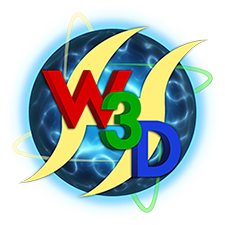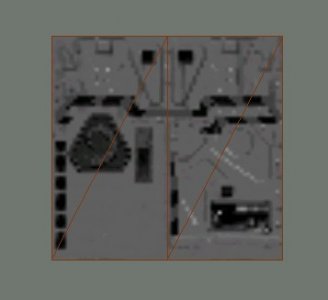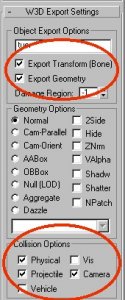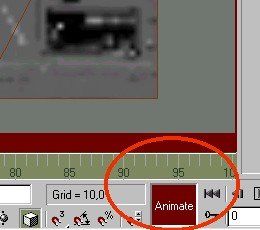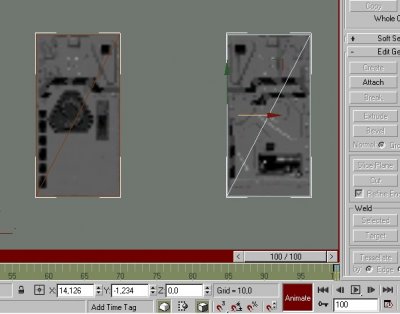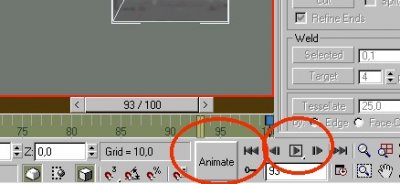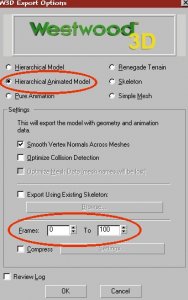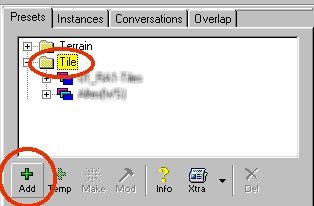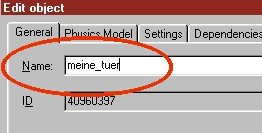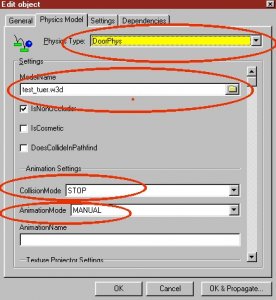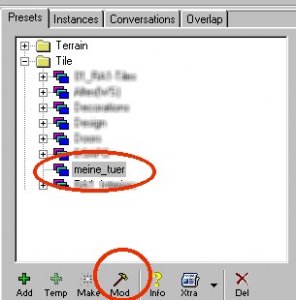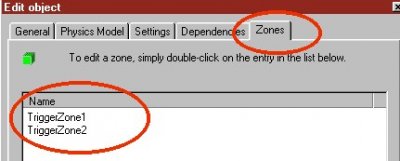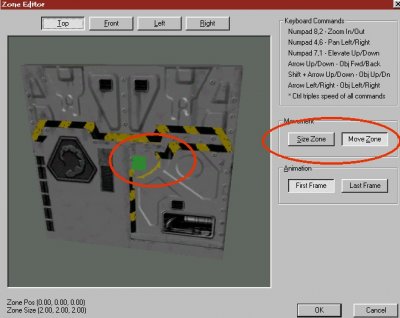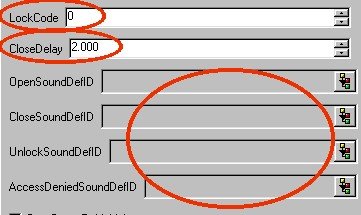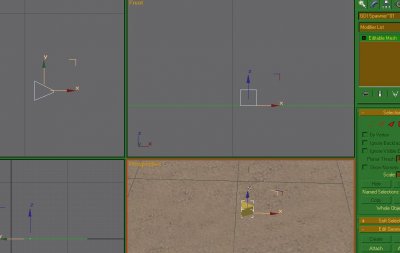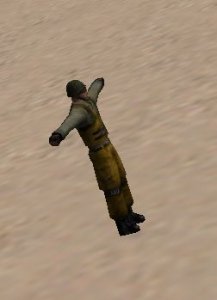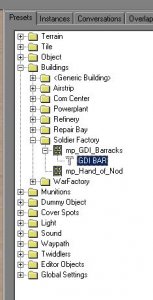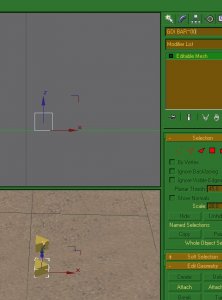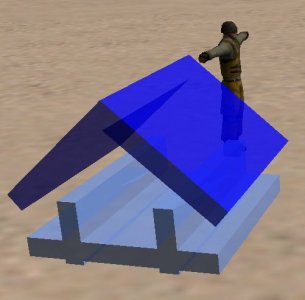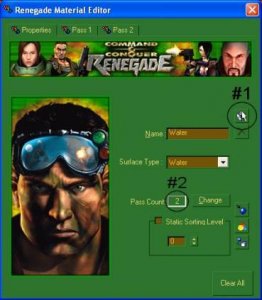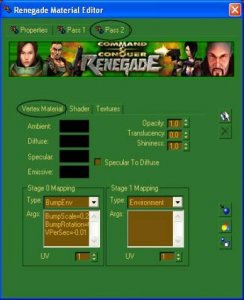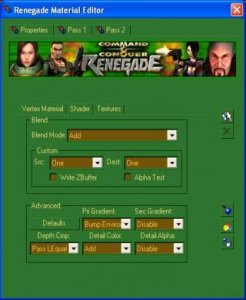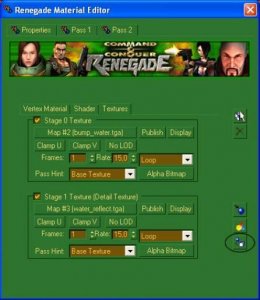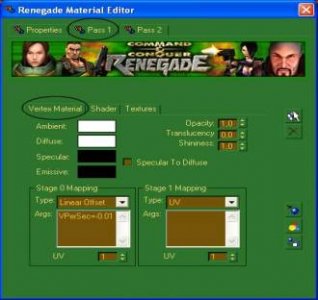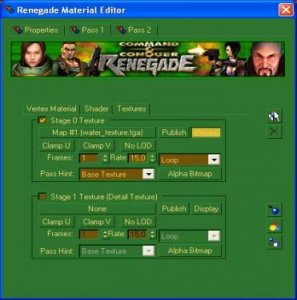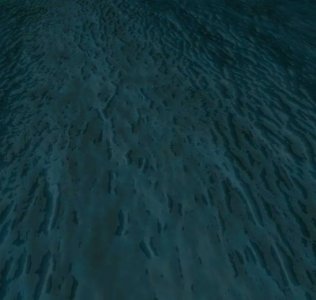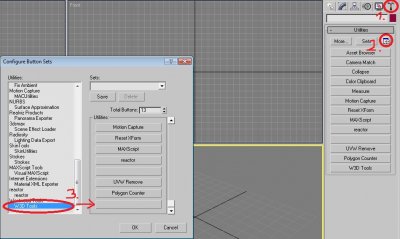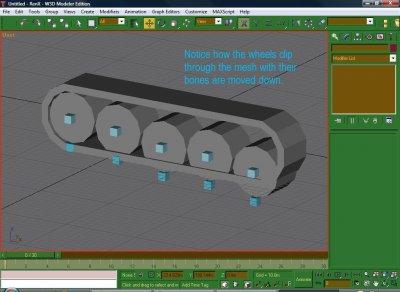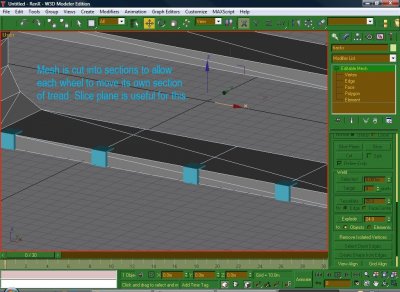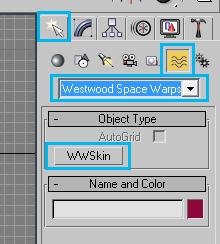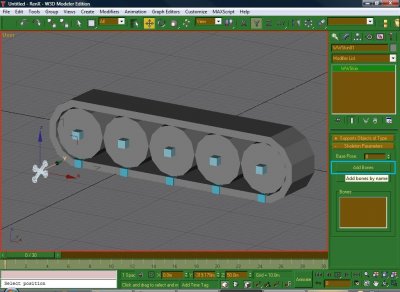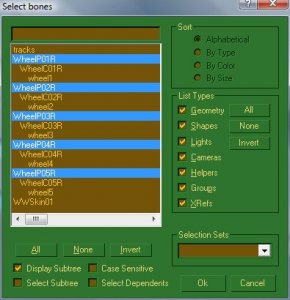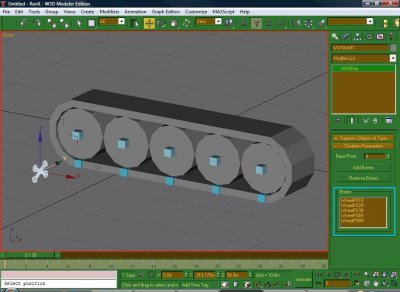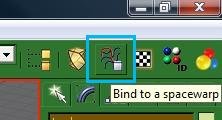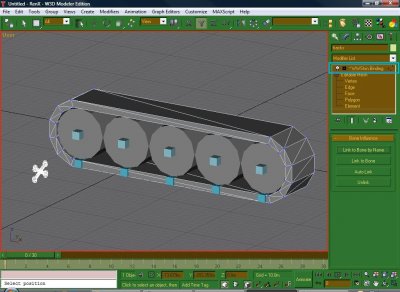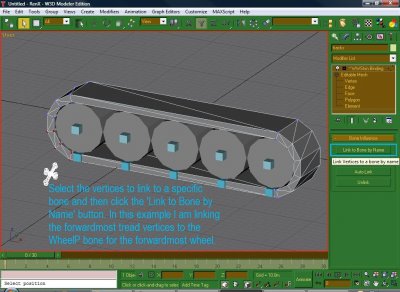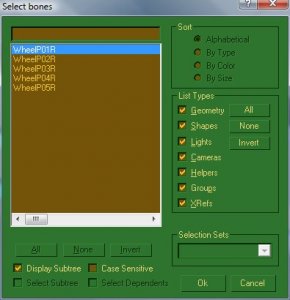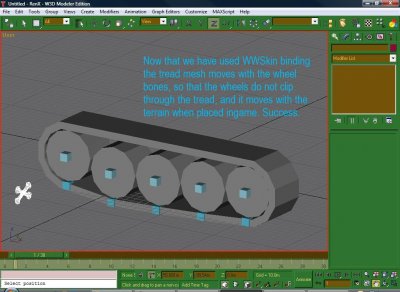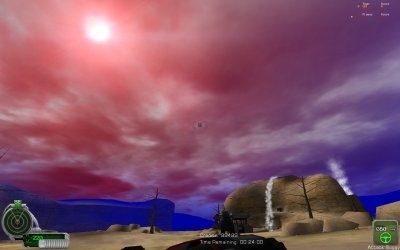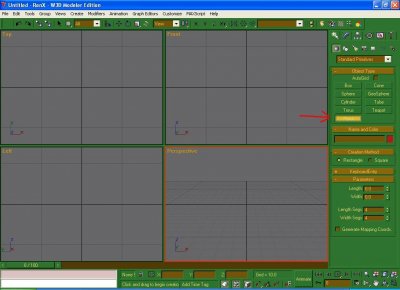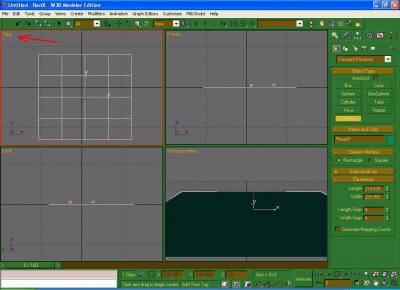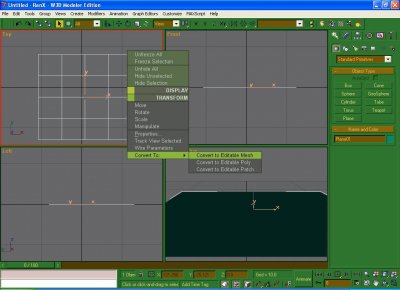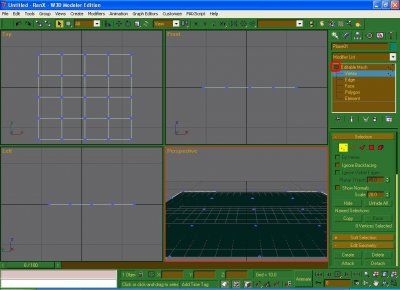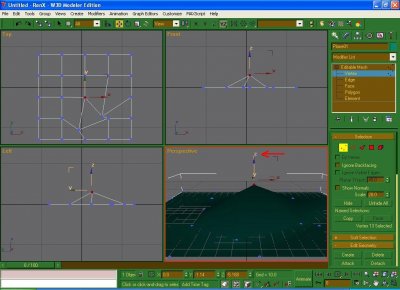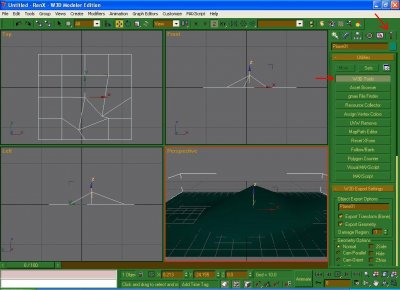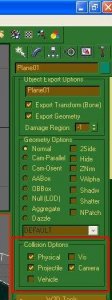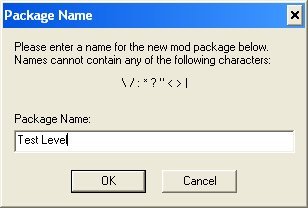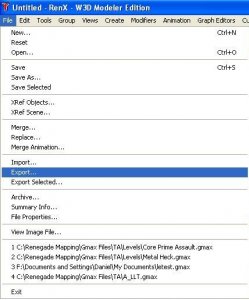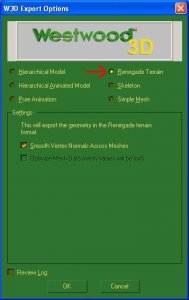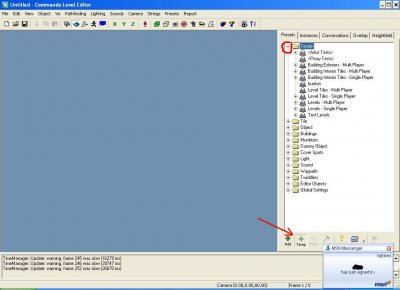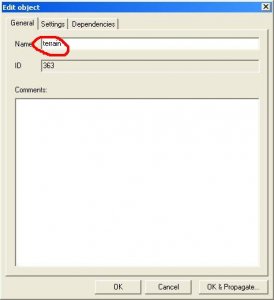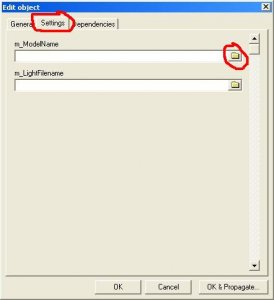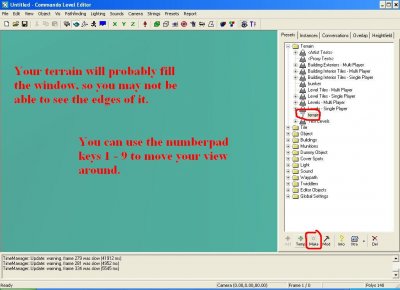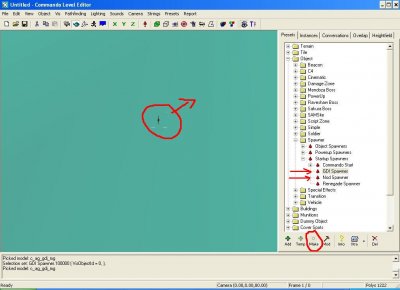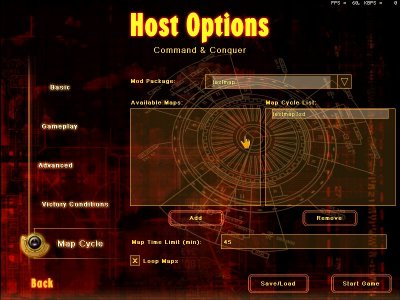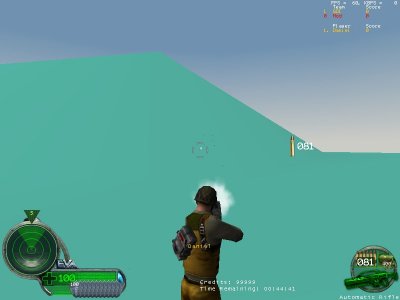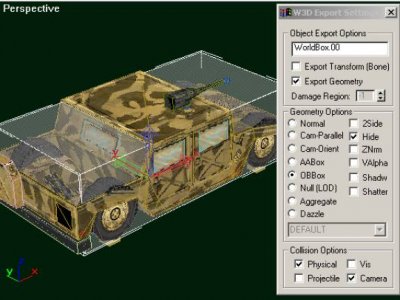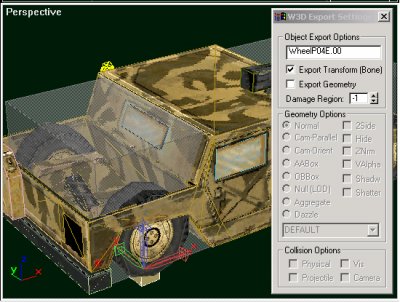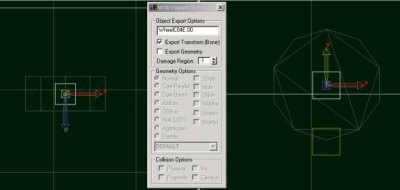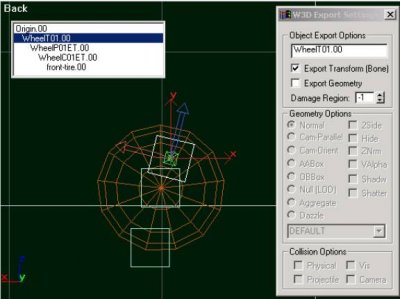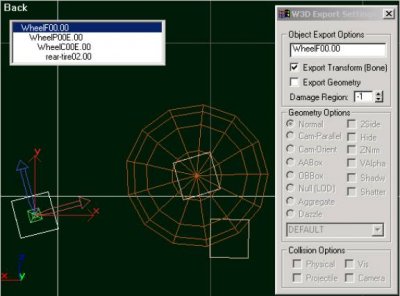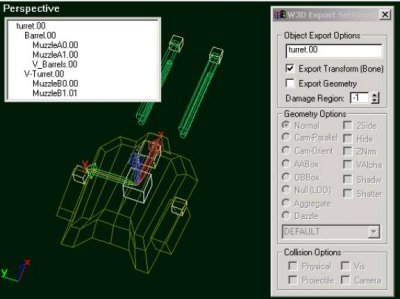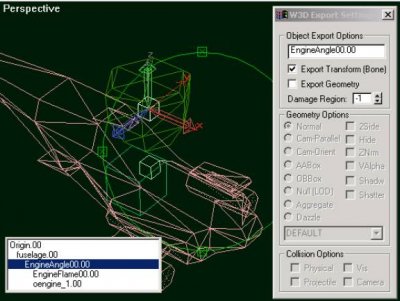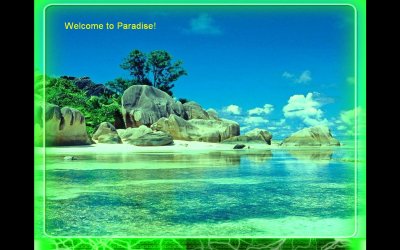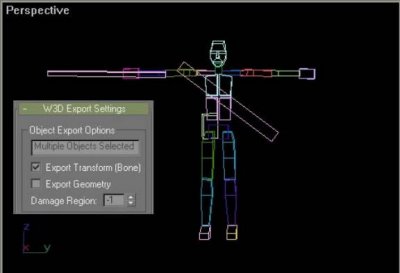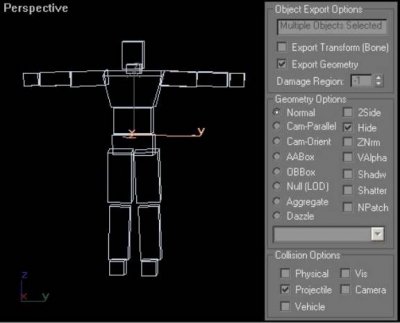-
Posts
5,437 -
Joined
-
Last visited
-
Days Won
121 -
Donations
60.00 USD
Content Type
Profiles
Forums
Events
Documentation
Bug Tracker
Downloads
Everything posted by moonsense715
-
Author: Läubi Skill level: 3 1. Create your door in GMAX/3ds Max (It may looks a bit like this Activate the W3D Collisions Settings: 2. Click at the Aniamte Button in the lower right corner: Scroll with the Frameslider at the right position(100) and move your door to the `open` position: Click at the Animate button once again. Have fun with your ready animation (viewable with the play button) 3. Export your file now into your Modfolder, the GMAX part is done now. 4. Open up the Commandoeditor and add a new Preset in the group Tiles: name your door: Change into the Physic Model Tab, and setup the following: (at the model name of course your W3D file) If you want that the door opens even for `empty` vehicles, like the one of the GDI weponsfactory activate the option, [x] DoorOpensForVehicles Now click at OK, that is needed for the following steps. 5. Select your door and click Mod: Now there is a new Tab Zones, there are two Zones. Double click at the TriggerZone1: The folowing window should popup: The green box is the Triggerzone, change the size and the position over `Size Zone` and `Move Zone` so that it is positioned in front of the door, do the same for the TriggerZone2, but position it at the back of the door. Click OK, and your door is now ready for use. Just click on Make and voliá! In the Physic Models Tab you can define some open/close sounds and times, or make the door a security door:
-
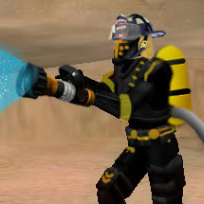
Tank Tracks + Wheels - Animation 3DS Max
moonsense715 replied to Shnappz's topic in Community Creations
You need to unwrap the tracks for them to "roll" properly. -
Author: Oblivion165 Skill level: 1 Proxies are probably my favorite thing in renegade. They make things a whole lot more stream-line and if you do your business right, you can make your maps load everything you need! -------------------------------------- 1. First off open your terrain, or make some. 2. Make a 1x1x1 Box somewhere on the terrain. 3. Make your box into a point at the X axis. Seen below Now name it "GDI Spawner~00" ~01 ~02 and so on for more than 1 spawner (The X axis is generally the "Front" Direction of many westwood models, including the player models) 4. Export as renegade terrain. PROXIES TO MY KNOWLEDGE ONLY WORK IF YOU EXPORT AS RENEGADE TERRAIN. Now make your terrain in LevelEdit and a GDI Spawner will be where you placed the proxie in Gmax! 5. Now make sure your spawner isnt touching anything like you normally would. As you can see his foot is in the sand. A Great Mapping Technique This is a really good idea to do when making maps. First go through the building controllers and make temps with shorter names. (Alot of them are longer than 16 characters long, Renx wont export it correctly) Go back to your terrain and do like you did with the spawner Now your building controllers will load with the map!!! You wont have to touch a thing! This works with just about everything, you can load tiberium fields, gun spawns, trees, PCT Zones, Bots, all sorts of things. Now when you have all your temps made, make a copy of the Temps in your mod folder, so when you start a new map, paste them in and its all ready to go.
-
Author: Bumpaneer, StoneRook, André Skill level: 1 First step, Id like to give big thanks for Bumpaneer on allowing me to write this tutorial on realistic water making for Renegade. Well, lets get started. 1. Load your Ren-X and make a plane 10x10 or bigger. Remember this is only to get you started, once you learn this tutorial, you will be able to make the water any size you wish. 2. Press the M key on your keyboard, which should open the Renegade Material Editor. 3. Click on the blue box icon (Make New Renegade Material) to avoid conflicts between a material already used in other object. Then, change the Pass Count to 2 and select the Surface Type (Naturally Water) as show in the picture below: 4. Usually, when you start by the Pass 1 tab, Ren-X crashes, so lets move on to Pass 2 tab, then we come back to set up the #1. Click on Vertex Material tab on Pass 2. Make sure Ambient, Diffuse, Specular and Emissive colors are black. Under the "Stage 0 Mapping" (bottom Left of screen). Select the drop down box to the right of Type and select "BumpEnv". And fill the box Args below with: BumpScale=0.2 BumpRotation=0.3 VPerSec=-0.01 And dont forget to change the Stage 1 Mapping Type to Environment (Basically to make it reflective) as shown in the picture below: 5. Now lets move to the Shader tab (Still inside Pass 2 Tab). Select the Blend Mode to Add. On the Advanced (Still on Shader Tab, but on bottom), select the Pri Gradient as Bump-Environment and the Detail Color as Add. Watch picture below: 6. Now lets move to the Textures tab to set up the textures and the details of the water and its movement. 7. Check the Stage 0 Texture and click on the None button to select the proper texture. Use the texture called bump_water.tga here. 8. Now check the Stage 1 Texture (Detail Texture) and click again on None button and select the texture named water_reflect.tga On next page you are going to see how your Textures tab should be after setting up all these changes. 9. Once you are done with setting up Vertex Material, Shader and Texture tabs on Pass 2, click on the button shown on the picture (Assign Material to Selection) to apply the changes to rhe object. 10. Now lets move back to Pass 1. On Vertex Material Tab, change the Stage 0 Mapping Type to Linear Offset and add VPerSec=-0.01 to the Args box, as shown in the picture on next page. Important Note: The Ambient, Diffuse, Specular and Emissive are already set up properly, you dont need to change them. 11. There is nothing to change or set up on Shader Tab, so lets move directly to the Textures Tab on Pass 1. 12. Check the Stage 0 Texturing and select the remaining texture included in the pack: water_texture.tga Once you select the texture, check the Display button and then, to finish, click once again on Assign Material to Selection button, wich will Finished Product: Tutorial Written by André. Realistic Water technique developed and improved by Bumpaneer and StoneRook. If you wish to know how to make more realistic effects for Renegade, start using WDump provided with the Renegade Mod Tools, there you can view all W3Ds Textures settings, making you be able to duplicate any effect Westwood added to their maps with textures. == Enjoy Your New Realistic Water ==
-
Author: Blazea58 Skill level: 2 Part 1 https://www.youtube.com/watch?v=6h7UdzG44W0 Part 2 https://www.youtube.com/watch?v=MrcYBavZzVA
-
Author: Hero2112 Skill level: 5
-
Author: Oblivion165 Skill level: 2 Part 1-6
-
Author: RenAlpha Skill level: 2 Part 1 Part 2
-
That's a good soviet repair node as well
-
Fixed your youtube embedding.
-
Author: moonsense715, ChopBam Skill level: 1 Hi and welcome to the tutorial that will get you started with modding/building in the W3D engine. This is merely a tutorial to set your tools up and running so you can start modding right away. Let's get to the point now since that's why you came here. Game Asset Creation To create content for the game, you will need a modeling software. Option 1: Gmax-RenX The smallest, simplest, free software out there is gmax 1.2. Unzip the file, start up gmax12.exe and hit "Setup". After self-extraction is completed, go through the installation process. Since Discreet/Autodesk no longer supports Gmax it is impossible to get a working Identification Code online. (They were always free in the past, they just sent the code to you in an e-mail, but that does not work anymore.) Therefore, there is a legal workaround that lets you "activate" Gmax. Double-click on Autodesk.reg to add it to your registry keys. (Feel free to read the Read_Me.txt file for more information about this.) W3D tool pack - RenX To make Gmax compatible with W3D, you need to install RenX from the Renegade Public Tools. Run the installer and go through the process. You can leave everything ticked, but: If you do not have C&C Renegade, the Level Editor that comes with Renegade Tools will not work properly. Now start up RenX from the installed RenegadePublicTools for the first time and choose a Display Driver. Feel free to use HEIDI Software Z Buffer and hit OK, since you can change this later if necessary anyway. Shortly after RenX starts up, the software will get recolored into a shade of green. You have finished installing GMax for W3D modding. Option 2: 3ds Max 8 - for advanced users Instead of using Gmax, you can also try 3ds max 8 for 30 days. It has better keyboard shortcut support and is a better choice if you plan to model and unwrap buildings, vehicles and weapons. Run Setup.exe to install it and run as a trial to try it out. If there are any errors about AcGe16.dll missing, you can probably find the file in C:\Program Files (x86)\Common Files\Autodesk Shared, and you can move it to your new 3DS Max folder (usually C:\Program Files (x86)\Autodesk\3dsMax8) - Setting up 3ds Max for W3D For using Max 8 to set up and export W3D content, you have to install the following: DirectX 2008 (even if you have a newer one) -Run directx_nov2008_redist.exe -Extract the .cab files to any folder -Run DXSETUP.exe, which will be in the folder you extracted the .cab files to 3DS Max Service Pack 3 -Run Setup_3dsMax8_SP3.msp W3D Scripts for 3DS Max -Copy the contents of W3D_Scripts.zip to your Max 8 directory (usually C:\Program Files(x86)\Autodesk\3dsMax8), as this contains the w3d plugins and the w3d importer -For ATI video card users: drop the contents of ati.zip into your max directory Now start up Max. When you launch for the first time, it will pop up with a "Graphics Driver Setup" window. Try using OpenGL as this is the best driver when it works. Otherwise, Software should do the trick. If you need to change the driver, from within the program you can go to Customize -> Preferences -> Viewports then click on Choose Driver and choose Software this time If you can't get into 3DS Max at all and you need to change the driver, go to Start -> Programs -> Autodesk -> Autodesk 3ds max 8 -> Change Graphics Mode to access the popup again, and choose Software Windows 10 Only: viewport freezing fix Copy the 3dsmax.exe in your executable folder. Paste it back in the same folder.. you will have a 3dsmax - copy.exe Change your desktop shortcut to run the -copy.exe version. Set the desktop shortcut to run as administrator Many people have reported this problem as being fixed when they follow these steps Windows 10 Only: fixing autobak Autobak (the process of the program auto backing up your work) may not work natively on Windows 10 due to the way permissions now work inside Program Files. You'll need to take control and possibly ownership of your Autobak folder inside C:\Program Files (x86)\Autodesk\3dsMax8 to allow 3ds max to write files to that directory You have to add the W3D Tools to your Utilities tab. Click Utilities (hammer icon), click Configure Button Sets and scroll down to Westwood Tools. Drag W3D Tools over to an empty button and hit OK. After all that, your 3ds Max 8 is now ready to create and export content into file formats the W3D engine works with. Level Editor Level Editor is where you manage your game content. You set up the physics for objects, give them health, armor, weapons, speed. For specific maps you set the game objective, place special script zones, edit the sun position along with the clouds, and so on. Every W3D game has its specialized editor. For a properly working Level Editor, you MUST have an installed W3D game on your computer. - Renegade Level Editor The Renegade Public Tools installer will have installed an old (non-scripts) version of LevelEdit. This version works but lacks many features. The latest version of LevelEdit is available in the TIberian Technologies Mod Tools: TT downloads page Replace your copy of LevelEdit with the one in the zip. Note: this version of LevelEdit will only work if you also have Tiberian Technologies scripts installed. - TS:Reborn Level Editor To install the TSR Editor, just download the file below and follow the instructions in the "How to install LE.txt" file. Download TSR LE Having a modeling software and Level Editor installed, you can go ahead and start creating/modding stuff in the W3D engine! Other tools W3D View This tool is used mostly to view W3D models, create emitters/sound emitters and create LOD for objects. Download W3D View RenegadeEx This is used to open files such as .mix or .pkg extension maps and mods as well as always.dat. You can extract files from them with this tool. Download RenegadeEx
-
Author: danpaul88 Skill level: 3 Foreword Before I start, this is only the second tutorial I have ever written, so bear with me. I will try to cover all the possible pitfalls and things to watch out for, and explain each step in detail, if you think something needs clarifying or altering do let me know. Thanks. About this tutorial This tutorial will explain the use of WWSkin objects to animate meshes using their verticies, which can create effects that could never be achieved using standard animation techniques. This is how Tank Tracks are able to move up and down with their wheels, and can also be used on any other object. Before you start Some important notes about WWSkin that you should be aware of before you start trying to apply it; WWSkin animation ONLY works in RenX, as the 3DS Max version of the Renegade W3D tools does not support WWSkin. Therefore, if you model in 3DS Max you must export your model and import it into RenX to setup the WWSkin binding. UPDATE: Apparently it DOES work in 3DS Max, but it's harder to find. Once you have bound a mesh to a WWSkin you cannot change that mesh without removing the WWSkin first, otherwise RenX generally crashes. Therefore it is a good idea to save a copy before you start applying the WWSkin, so that you can go back to that if you realise you need to change something. The Tutorial I will use a simple tank tread as an example, taken a WIP version of the AR Chronominer. I have deleted all the other meshes in the scene to make it easier to see what's happening in screenshots. Before this I start explaining WWSkin you should know that the wheel bones are setup as normal, the wheels linked to the WheelC bones and those linked to the WheelP bones, which are at the same Z height as the bottom of the track mesh. These first two screenshot shows that the wheels moving up and down do not affect the position of the mesh, which would cause it to clip through the terrain. You should also note how the bottom of the Track mesh has been cut into slices as long as the gap between each wheel bone, we have to do this so we have vertices in the right place to link to the bones later on. Now that we have seen what happens without WWSkin binding applied to the treads, lets setup WWSkin binding and see what difference this makes. The first thing to do is create our WWSkin object, so go to the toolbar at the top and hit the button labelled 'Create a Renedage Skin' (yes, it really is spelt wrong in the W3D Tools). If your using 1024x768 like I am you will only about half of the icon, because it runs off the end of the toolbar, if you can't see it at all click on one of the || dividers on the toolbar and drag it to the left until it comes into view. For 3DS Max users If your using 3DS Max you can find the WWSkin object under the Spacewarps tab on the meshes section of the right hand side menu. Once you click the button you then have to click on your scene to create what looks like a set of crossed bones. Place this anywhere on your scene, it does not matter where, but if your using more than one on your scene it would be a good idea to place it somewhere near the mesh you are using it on. Select this new object and click the 'Add Bones' button on the right hand side. A window will pop up listing all the objects in your scene. You need to select all the bones that you will use to animate this mesh, and then click OK. In this example we are rigging a tank tread, so we need to choose all the WheelP bones for this tread. Once you have clicked OK they should appear in the list of bones for the WWSkin on the right. Ok, now that we have selected the bones that will be used in this WWSkin we have to link it to a mesh. You can only link one mesh to each WWSkin object, so if you need to animate multiple meshes you must create additional WWSkin objects. Bones can be used by more than one WWSkin object, so if a bone needs to move two or more meshes it can be linked to the WWSkin objects for all of those meshes. Select the 'Bind to Spacewarp' button on the toolbar (again, if like me your using 1024x768 this will appear off the end of the screen, click one of the | dividers on the toolbar and drag it to the left until you can see the button shown in the screnshot). Now click on your mesh, hold the mouse button, drag the icon to the WWSkin object and release, the same way you would to link objects to bones. The mesh should now have a 'WWSkin Binding' modifier on the right, and it's verticies will be highlighted. For 3DS Max users If your using 3DS Max the 'Bind to Spacewarp' button looks the same as it does in RenX, but is positioned on the far left of the toolbar, next to the buttons for linking and unlinking meshes. Handy Tip If your mesh changes position or size or does other wierd things when you bind it to the WWSkin hit undo the remove the WWSkin binding, and reset the meshes Xform by going to the Utilities tab (Hammer Icon) and choosing 'Reset Xform', and then click 'Reset Selected' with the mesh selected. This may turn your mesh inside out, if so go back to the Modify tab, select Polygon editing mode from the Editable Mesh dropdown, select all the polygons on your mesh and hit 'Flip Normal' to turn it the right way out again. You can then link to the WWSkin as normal Ok, now your mesh is linked to the WWSkin, the final step is to link the mesh vertices to their bones. Select the vertices that need to move with a particular bone, and then click 'Link to Bone by Name' on the right. Then simply select the bone to link them to from the list, and click OK. Select the next group of vertices to move with the next bone and do the same to link them to that bone, and repeat until all the vertices that need to move with a bone are linked to that bone. Each vertex can only be linked to a single bone. Note, you can also use 'Link to Bone' instead of 'Link to Bone by Name', which allows you to click a bone on the scene to link to, but I find it easier to use the object listing to do it. This is down to personal preference though. Once you are done linking vertices click the + icon next to the 'WWSkin Binding' and click the vertices text that comes up below this to allow you to deselect the mesh. You can only link vertices to bones that you previously added to the WWSkin object, if you need to add more bones select the WWSkin object and add them the same way we did earlier. The final result Ok, so what did we achieve by doing that? If you scroll up you will see the first image showed that moving the wheel bones up and down caused the wheel bones to clip through the mesh, so lets see what happens now that we have used WWSkin binding on the tread mesh to link it to the wheel bones. Create a 1 frame animation and move some of the WheelP bones up or down while in animation mode. The mesh will move with the bones, creating a much more realistic appearance. In our tread example, the treads will now fluctuate up and down with the terrain, instead of just being flat all the time. Exactly what we wanted to achieve. You can download my example file here to look at how it is setup, this is the completed gmax file I created while doing this tutorial. I trust that whoever created this simply tread for the Chronominer does not mind me using it for this tutorial example. WWSkin_Binding_Example.zip Footnote If you have any further questions, or suggestions to improve this tutorial, please do post them. I have tried to be thorough and cover the entire process from start to finish, but it is easy to forget to mention a step that seems obvious to you because you do it all the time, so if I missed something out please do mention it and I will update the tutorial. Good luck, and happy modding!
-
Author: Jonwil, moonsense715 Skill level: 2 Jonwil has just added a feature to scripts (4.2, 4.3 and 5.0) that lets you have custom sky colors on any map, in case you can not get what you want by changing the time of day in LevelEdit. For example you can not get a full red or green sky normally. ATTENTION! Using this feature will completely overwrite all the sky/sun/etc. color settings set by LevelEdit. If you want to change anything in the list, prepare that you will have to set everything yourself, not just the parts you wish to alter. 1. Preparation So let's say you want custom sky, sun, moon, etc colors for a map named: TS_Mars.mix. Get a scripts build that supports this feature from here. Copy its content to your game folder (not Data) and overwrite all. Create a file named TS_Mars_map.ini. Inside this ini file write/copy this section: [SkyColors] OverrideSkyColors=true ; Warm sky color - Clouded sky's additional color around the sun ; Normally changes with set time of day and is a transition color inbetween the sun/halo and Cold sky colors WarmSkyColorRed=230 WarmSkyColorGreen=230 WarmSkyColorBlue=230 ; Cold sky colors - Clouded sky's additional color everywhere else + Fog color (bottom skydome) ; Fog color in LE is affected by cloud gloominess and time of day, copy the fog color with no gloominess applied ColdSkyColorRed=230 ColdSkyColorGreen=230 ColdSkyColorBlue=230 ; Sun color; - Normally changes with set time of day SunColorRed=75 SunColorGreen=75 SunColorBlue=75 ; Sun halo color; - Normally changes with set time of day SunHaloColorRed=100 SunHaloColorGreen=100 SunHaloColorBlue=100 ; Moon halo color MoonHaloColorRed=255 MoonHaloColorGreen=255 MoonHaloColorBlue=255 ; Sky color (top skydome); - Normally changes with set time of day SkyColorRed=112 SkyColorGreen=146 SkyColorBlue=176 ; Cloud gloominess color GloominessColorRed=255 GloominessColorGreen=255 GloominessColorBlue=255 ; Star field transparency, 255 - Stars appear (good for clear sky night time); 0 - No stars StarfieldAlpha=0 The comments in the code should help you understand what affects what exactly.This setup is 99% similar to what the sky looks like with the default map time setting in LevelEdit (15:00 / 3:00 pm). 2. Customize the colors Change the colors to suit your taste. For example you can have a red sky around the sun and blue fog. I don't recommend going overboard with the colors as it can look wierd. I suggest adding little color additions only; except if it's an extreme map. Here's an example that you should never do, (but can do): 3. Finish Export your map with this new ini file included in it and enjoy the new colors! Note: you have to restart the map (but not the game) for any color changes in the ini file to take effect, if you have the ini file in the Data folder during color testing.
-
I'm not looking at that part of the quote. I'm looking at the part where OWA says, "We are willing to remove APB from our launcher if the developers request it, so we only ask that you give us the same liberty." For that, OWA has to answer
-
Keyword: "prefer". Not forcing or starting drama. We accounted for that we have no word or control over what somebody's launcher can do.
-

5 - Advanced UVW Unwrapping 101 with OWA
moonsense715 posted a topic in Modelling, Unwrapping & Texturing
Author: @OWA Skill level: 5 -
Author: Westwood Studios Skill level: 3 Here is a list of presets that are useful in text cinematic scripting. The presets can be found in LevelEdit if you need to see what the actual object is. CnC_GDI_MiniGunner_3Boss_ALT2 CnC_GDI_MiniGunner_3Boss_ALT3 CnC_GDI_MiniGunner_3Boss_ALT4 CnC_Ignatio_Mobius_ALT2 Mobius in Prototype Assault Suit CnC_Sydney_PowerSuit_ALT2 Ion Cannon Sydney in regular clothing CnC_Nod_FlameThrower_3Boss_ALT2 Mendoza in flamethrower clothing CnC_Nod_MiniGunner_3Boss_ALT2 CnC_Nod_RocketSoldier_3Boss_ALT2 Raveshaw mutant skin CnC_GDI_Grenadier_0_Secret Nurse with Grenade Launcher CnC_Visceroid Visceroid CnC_Nod_Flamethrower_0_Secret Cook with a flamethrower CnC_Nod_RocketSoldier_3Boss_Secret Kane CnC_Nod_RocketSoldier_3Boss_Secret2 Ghost of Raveshaw? CnC_POW_MineTimed_Player_01 CnC_Nod_RocketSoldier_0_Secret CnC_GDI_RocketSoldier_2SF_Secret CnC_Chicken --causes game to crash CnC_GDI_MiniGunner_2SF_Logan Logan CnC_Sydney_PowerSuit_Petrova CnC_Nod_FlameThrower_3Boss_Petrova CnC_GDI_Engineer_0 CnC_POW_MineRemote_02 CnC_POW_MineTimed_Player_01 CnC_GDI_Engineer_2SF CnC_MineProximity_05 CnC_POW_MineTimed_Player_02 CnC_GDI_Grenadier_0 GDI Grenadier (from single player?) CnC_Sydney Sydney from Single Player?? CnC_Ignatio_Mobius Mobius from Single Player CnC_GDI_MiniGunner_0 GDI Basic Infantry CnC_GDI_MiniGunner_1Off CnC_GDI_MiniGunner_2SF GDI Deadeye CnC_GDI_MiniGunner_3Boss GDI Havoc CnC_GDI_RocketSoldier_0 GDI Grenadier CnC_GDI_RocketSoldier_1Off GDI Rocket Soldier? CnC_GDI_RocketSoldier_2SF GDI Gunner CnC_Sydney_PowerSuit Personal Ion Cannon Sydney (in Prototype Assault Suit) CnC_GDI_Mutant_0_Mutant CnC_Nod_Mutant_0_Mutant CnC_GDI_Mutant_1Off_Acolyte CnC_Nod_Mutant_1Off_Acolyte CnC_GDI_Mutant_2SF_Templar CnC_Nod_Mutant_2SF_Templar CnC_Nod_Minigunner_0 Nod Basic Infantry CnC_Nod_Minigunner_1Off CnC_Nod_Minigunner_2SF Nod Black Hand Sniper CnC_Nod_Minigunner_3Boss Sakura CnC_Nod_RocketSoldier_0 CnC_Nod_RocketSoldier_1 Nod Rocket Soldier CnC_Nod_RocketSoldier_2SF Black Hand Rocket Infantry CnC_Nod_RocketSoldier_3Boss Raveshaw CnC_Nod_FlameThrower_0 Nod Flamethrower CnC_Nod_FlameThrower_1Off CnC_Nod_FlameThrower_2SF Nod Chem Warrior CnC_Nod_FlameThrower_3Boss Nod Mobius CnC_Nod_Engineer_0 Nod Engineer CnC_Nod_Technician_0 Nod Technician CnC_MineProximity_05 CnC_GDI_Grenadier_2SF CnC_Ignatio_Mobius_Skirmish GDI Mobius from Multiplayer Practice CnC_Sydney_Skirmish Tiberium AutoRifle Sydney from Multiplayer Practice CnC_GDI_RocketSoldier_2SF_Skirmish Gunner from Multiplayer Practice CnC_GDI_MiniGunner_3Boss_Skirmish Havoc from Multiplayer Practice CnC_GDI_MiniGunner_0_Skirmish GDI Basic Infantry from Mutiplayer Practice CnC_Nod_MiniGunner_3Boss_Skirmish Sakura from Multiplayer Practice CnC_Nod_RocketSoldier_3Boss_Skirmish Raveshaw from Multiplayer Practice CnC_Nod_MiniGunner_0_Skirmish Nod Basic Infantry from Multiplayer Pracice CnC_Nod_MiniGunner_2SF_Skirmish Black Hand Sniper from Multiplayer Practice CnC_Death_Powerup Crate that kills you when you go over it?? CnC_Crate_Powerup CnC_POW_Ammo_Clip01 crate that refills your ammo CnC_POW_Ammo_Clip02 crate that refills your ammo CnC_POW_Ammo_Clip04 crate that refills your ammo CnC_Money_Crate crate that gives you 100 credits M00_CNC_Crate ????? CnC_POW_AutoRifle_Player_GDI GDI Autorifle Spawn CnC_POW_AutoRifle_Player_Nod Nod Autorifle Spawn CnC_POW_RocketLauncher_Player Rocket Launcher Spawn CnC_POW_VoltAutoRifle_Player_Nod Mendozas Volt Auto Rifle Spawn CnC_POW_MineRemote_01 CnC_POW_MineRemote_02 CnC_POW_MineTimed_Player_01 CnC_POW_MineTimed_Player_02 CnC_POW_RepairGun_Player Spawn Repair gun CnC_MineProximity_05 CnC_POW_Ammo_ClipMax Pickup that maxes out your clips?? CnC_POW_Armor_Max CnC_POW_Health_Max CnC_POW_IonCannonBeacon_Player CnC_POW_Nuclear_Missle_Beacon CnC_Ammo_Crate CnC_Nod_Cargo_Drop CnC_Nod_Truck_Player_Secret CnC_GDI_Orca GDIs VTOL Orca CnC_Nod_Apache Nods Apache CnC_Civilian_Pickup01_Secret GDIs pickup truck (Extra)?? CnC_Civilian_Sedan01_Secret GDIs sedan (Extra)?? gdi_hovercraft GDI Hovercraft from Singleplayer (cannot be piloted) CnC_Nod_Transport Nod Transport Chopper CnC_GDI_Transport GDI Transport Chopper CNC_GDI_Gun_Emplacement GDI Gun Emplacement CnC_GDI_Humm-vee GDI Hummer CnC_Nod_Buggy Nod Buggy CnC_Rocket_Emplacement Rocket Emplacement CnC_Cannon_Emplacement Cannon Emplacement CnC_NOD_Gun_Emplacement Nod Gun Emplacement CnC_Nod_Ceiling_Gun Nod Ceiling gun---------- CnC_GDI_Ceiling_Gun Ceiling Gun from AGT CnC_GDI_Harvester GDI Harvester (doesnt include scripting) CnC_Nod_Harvester Nod Harvester (doesnt include scripting) CnC_GDI_APC GDI APC CnC_GDI_Mammoth_Tank GDI Mammoth Tank CnC_GDI_Medium_Tank GDI Medium Tank CnC_GDI_MRLS GDI Mobile Rocket Launcher System CnC_Nod_APC Nod APC CnC_Nod_Flame_Tank Nod Flame Tank CnC_Nod_Light_Tank Nod Light Tank CnC_Nod_Mobile_Artillery Nod Mobile Artillery Unit CnC_Nod_Recon_Bike_Player Nod Recon Bike CnC_Nod_Stealth_Tank Nod Stealth Tank CnC_Beacon_IonCannon Ion Cannon Beacon CnC_Beacon_NukeStrike Nuclear Strike Beacon CNC_Weapon_Flamethrower_Player Flamethrower Weapon CNC_Weapon_ChemSprayer_Player Chemsprayer Weapon CNC_Weapon_Orca_Rocket CNC_Weapon_Apache_MachineGun CnC_Weapon_Orca_HeavyMachineGun CnC_Weapon_Apache_Rocket CnC_Weapon_APC_M60MG CnC_Weapon_APC_M60MG_RedTracer Weapon_CnC_Ceiling_Gun_GDI CnC_Weapon_MineTimed_Player CnC_Weapon_MineTimed_Player_2Max CnC_Weapon_MineRemote_Player CnC_Weapon_MineRemote_Player_2Max CnC_Weapon_AutoRifle_Player CnC_Weapon_AutoRifle_Player_Nod CnC_Weapon_RocketLauncher_Player CnC_Weapon_RepairGun_Player_Special Weapon_CnC_Ceiling_Gun_Nod CnC_Weapon_RamjetRifle_Player Ramjet Sniper Rifle Weapon CnC_Weapon_SniperRifle_Player Deadeye`s Snipe Rifle CnC_Weapon_SniperRifle_Player_Nod Black Hand Sniper Rifle CnC_Weapon_IonCannonBeacon_Player Ion Cannon Beacon CnC_Weapon_NukeBeacon_Player Nuclear Strike Beacon CNC_Ammo_Flamethrower_Player Flamethrower Ammo CNC_Ammo_ChemSprayer_Player Chemsprayer Ammo CnC_Ammo_Orca_Rocket CnC_Ammo_Apache_Rocket CnC_Ammo_Apache_HeavyMachineGun CnC_Ammo_APC_M60MG CnC_Ammo_APC_M60MG_RedTracer CnC_Ammo_Orca_HeavyMachineGun Ammo_CnC_Ceiling_Gun_GDI CnC_Ammo_RocketLauncher_Player CnC_Ammo_RepairGun_Player_Special Ammo_CnC_Ceiling_Gun_Nod CnC_Ammo_RamjetRifle_Player CnC_Ammo_SniperRifle_Player CnC_Ammo_SniperRifle_Player_Nod CnC_Ammo_IonCannonBeacon_Player CnC_Ammo_NukeBeacon_Player CnC_Explosion_Shell_Rocket M00_Nod_Obelisk_CNC Weapon_Shotgun_Player Weapon_SniperRifle_Player Weapon_RocketLauncher_Player Ammo_Shotgun_Player Ammo_SniperRifle_Player Ammo_Chaingun_Player Weapon_Flamethrower_Player Ammo_Flamethrower_Player Weapon_Pistol_Player Ammo_Pistol_Player Ammo_GrenadeLauncher_Player Weapon_Chaingun_Player Weapon_GrenadeLauncher_Player Ammo_MineTimed_Player Weapon_MineRemote_Player Weapon_MineTimed_Player Ammo_RocketLauncher_Player Ammo_MineRemote_Player Ammo_MineProximity_Player Weapon_MineProximity_Player Ammo_ChemSprayer_Player Ammo for Chemsprayer Weapon Weapon_ChemSprayer_Player Chemsprayer Weapon POW_Pistol_Player This is the pistol you always have. Semi-auto, 12 shot clip. POW_Shotgun_Player This is the shotgun carried by Shotgun Troopers POW_SniperRifle_Player This is the Sniper Rifle carried by Black Hand Snipers and Deadeye POW_RocketLauncher_Player This is the Rocket Launcher carried by Rocket infantry. POW_MineRemote_Player The basic remote C4. POW_GrenadeLauncher_Player The GDI Grenade Launcher POW_Chaingun_Player The Officer Chaingun POW_ChemSprayer_Player The Nod Chemsprayer weapon POW_Flamethrower_Player Flamethrower POW_RepairGun_Player Repairgun (regular engineers) POW_IonCannonBeacon_Player Ion Cannon Beacon POW_LaserChaingun_Player Laser Chaingun (Black hand) POW_VoltAutoRifle_Player Volt Auto (Mobiuss) POW_RamjetRifle_Player The Ramjet Sniper Rifle (Havoc + Sakura) POW_LaserRifle_Player Stealth Black Hand Laser rifle POW_MineTimed_Player Timed C4 POW_MineProximity_Player Proximity C4 POW_AutoRifle_Player Basic Infantry Auto Rifle POW_PersonalIonCannon_Player Sydneys Pesonal Ion Cannon POW_TiberiumAutoRifle_Player Sydneys Tiberium Auto Rifle POW_TiberiumFlechetteGun_Player Patchs Tiberium Flechette Gun POW_Railgun_Player Raveshaws Railgun POW_AutoRifle_Player_Nod Nod Autorifle (Mendozas) POW_Chaingun_Player_Nod Nod Officer Chaingun POW_SniperRifle_Player_Nod Nod Black Hand Sniper rifle GDI_APC_Player GDI APC GDI_Humm-vee_Player GDI Hummer GDI_Mammoth_Tank_Player GDI Mammoth Tank GDI_Medium_Tank_Player GDI Medium Tank GDI_MRLS_Player GDI Mobile Rocket Launcher System Nod_APC_Player Nod APC Nod_Buggy_Player Nod Buggy Nod_Flame_Tank_Player Nod Flame Tank Nod_Light_Tank_Player Nod Light Tank Nod_Mobile_Artillery_Player Nod Mobile Artillery Nod_Recon_Bike_Player Nod Recon Bike Nod_SSM_Launcher_Player Nod Surface to Surface Rocket Launcher (DO NOT FIRE!!) Nod_Stealth_Tank_Player Nod Stealth Tank Nod_Gun_Emplacement_Player Nod Gun Emplacement Nod_Turret_MP Nod Defensive Turret Nod_Cannon_Emplacement_Player Nod Cannon Emplacement Nod_Rocket_Emplacement_Player Nod Rocket Emplacement Weapon_IonCannonBeacon_Player Weapon_LaserRifle_Player Weapon_AutoRifle_Player Weapon_LaserChaingun_Player Weapon_PersonalIonCannon_Player Weapon_RamjetRifle_Player Weapon_TiberiumAutoRifle_Player Weapon_TiberiumFlechetteGun_Player Weapon_VoltAutoRifle_Player Weapon_RepairGun_Player Weapon_StealthTank_Player Weapon_ReconBike_Player Weapon_MediumTank_Cannon_Player Weapon_MammothTank_Rocket_Player Weapon_MammothTank_Cannon_Player Weapon_LightTank_Cannon_Player Weapon_Humm-Vee_M60MG_Player Weapon_FlameTank_Player Weapon_Emplacement_Rocket_Player Weapon_Emplacement_Gun_Player Weapon_Emplacement_Cannon_Player Weapon_Buggy_M60MG_Player Weapon_APC_M60MG_Player Weapon_Railgun_Player Weapon_NukeBeacon_Player Weapon_SSM_Player Weapon_MRLS_Player Weapon_MobileArtillery_Cannon_Player Weapon_Chaingun_Player_Nod Weapon_AutoRifle_Player_Nod Weapon_SniperRifle_Player_Nod Weapon_Nod_APC_Player Weapon_VoltAutoRifle_Player_Nod Ammo_IonCannonBeacon_Player Ammo for Ion Cannon Beacon Ammo_LaserRifle_Player Ammo for the Stealth Black Hand Laser Rifle Ammo_AutoRifle_Player Ammo for the GDI Autorfile (Mendozas) Ammo_LaserChaingun_Player Ammo for the Black Hand Laser Chaingun Ammo_PersonalIonCannon_Player Ammo for Sydneys Personal Ion Cannon Ammo_RamjetRifle_Player Ammo for Havoc or Sakuras Sniper Rifle Ammo_TiberiumAutoRifle_Player Ammo for Sydneys Tiberium Auto Rifle Ammo_TiberiumFlechetteGun_Player Ammo for Patchs Tiberium Flechette Gun Ammo_VoltAutoRifle_Player Ammo for Mobiuss Volt Auto Rifle Ammo_RepairGun_Player Ammo for the Engineers Repair gun Ammo_RepairGun_Player_Alternate Ammo for Technician/Hotwires repair gun Ammo_StealthTank_Player Ammo for the Stealth Tank Ammo_ReconBike_Rocket_Player Ammo for the Recon Bike Ammo_MediumTank_Cannon_Player Ammo for the Medium Tank Ammo_MammothTank_Rocket_Player Rocket ammo for the Mammoth Ammo_MammothTank_Cannon_Player Cannon Ammo for the Mammoth Ammo_LightTank_Cannon_Player Ammo for the Light Tank Ammo_Humm-Vee_M60MG_Player Ammo for the Hummers Machine gun Ammo_FlameTank_Player Ammo for the Flame tank Ammo_Emplacement_Rocket_Player Ammo for the Rocket Emplacement Ammo_Emplacement_Gun_Player Ammo for the Gun Emplacement Ammo_Emplacement_Cannon_Player Ammo for the Cannon Emplacement Ammo_Buggy_M6C Ammo for the Buggys machine gun Ammo_APC_M60MG_Player Ammo for the APCs machine gun Ammo_Railgun_Player Ammo for Raveshaws Railgun Ammo_MobileArtillery_Player Ammo for the Mobile Artillery Unit Ammo_NukeBeacon_Player Ammo for the Nuclear Strike Beacon Ammo_SSM_Player Ammo for the SSM (DO NOT FIRE!!) Ammo_MRLS_Player Ammo for the Mobile Rocket Launcher System Ammo_AutoRifle_Player_Nod Ammo for Mendozas Autorifle?? Ammo_SniperRifle_Player_Nod Ammo for Nods Black Hand Sniper Rifle Ammo_Chaingun_Player_Nod Ammo for the Nod Officers Chain gun Ammo_Nod_APC_Player Ammo for the Nod APC Ammo_VoltAutoRifle_Player_Nod Ammo for Mendozas Autorifle?? CnC_GDI_Grenadier_0_Secret GDI Nurse with Grenade Launcher (Extra) CnC_Nod_Flamethrower_0_Secret Nod Chef with flame thrower (extra) CnC_Nod_RocketSoldier_3Boss_Secret CnC_Nod_RocketSoldier_3Boss_Secret2 CnC_Nod_RocketSoldier_0_Secret CnC_GDI_RocketSoldier_2SF_Secret CnC_Nod_Truck_Player_Secret Nod Cargo Truck. Cool! CnC_Civilian_Pickup01_Secret GDI Pickup Truck (Extra) CnC_Civilian_Sedan01_Secret GDI Sedan (Extra) Mx0_Nod_Obelisk Nod Ceiling Gun, can fire Obelisk laser PCT_Zone_GDI GDI Purchase Terminal. Functional, but does not show screen. PCT_Zone_Nod Nod Purchase Terminal. Functional, but does not show screen. Big_Gun_Phat GDI Costal Gun, add M05_Nod_Gun_Emplacement to make it shoot. M01_GDI_Gunboat A GDI gunboat, will shoot if given AI. GDI_A10_Flyover The GDI A10, nonfunctional. Nod_Comanche Sakura`s Comanche SignalFlare_Gold_Phys3 A Yellow-smoke Flare Create_Object Items To create these items, use Create_Object V_Jet A Nod VIP jet, cannot be flown. Enc_gcon GDI Construction yard?? V_Submarine A non-functional submarine V_Nod_Cargop_s The Nod C130 Cargo Plane Structures: To create these non-functional structures, use Create_Object, not Create_Real_Object enc_gbar GDI Barracks. Non-functional. enc_gbar Nod Airstrip wep#shunt This is the door of the weapons factory.... enc_gwep Weapons Factory, non functional. enc_gref GDI Refinery, non functional. Parachute Stuff: See Example H_A_X5D_ParaT_1 Animation of Parachute Falling X5D_Box01 Box attached to parachute by default, placeholder for items/units dropped by parachute X5D_Box01.X5D_Box01 Animation of the box falling with the parachute X5D_Parachute Parachute call name Scripts: M01_Hunt_The_Player_JDG This is the AI for the bot to hunt players in a game. M00_No_Falling_Damage_DME When bots or vehicles fall, they are not damaged M06_Thunder_Unit Makes bots drop rocket launchers when they die M00_Disable_Physical_Collision_JDG Vehicles can pass through barriers. Common Application M00_Damage_Modifier_DME","0,1,1,0,0" Makes it so that units cannot lose health (invincibility) Mx0_Obelisk_Weapon_DLS Makes units invisible. Not Stealth, true Invisible GTH_Credit_Trickle Modify the number of credits recieved per second. - ,"10" = 10 credits/second M05_Nod_Gun_Emplacement AI for turrets, good for non-skirmish bots also M05_Park_Unit A secondary AI for bots? M02_PLAYER_VEHICLE 90 sec AI for vechs dropped by c130, autopilots them off of Airstrip. M00_Disable_Transtition When attached to a vehicle, no one can get in that vehicle. This list was provided by Westwood Studios & kawolsky
-
Author: danpaul88 Skill level: 1 LevelEdit Change Z height You can hold shift on the keyboard to alter the height of an object (or group of objects) whilst dragging with the mouse or using the up/down arrows on the keyboard. This is quicker than selecting the Z axis button on the toolbar every time you want to change an objects height. Clone Object You can create clones of an object (or group of objects) using the standard ctrl+c, ctrl+v keyboard shortcuts for copy & paste, but the location of the new objects is somewhat arbitrary depending on where you are looking. dtrngd recently told me about a better method; Select the object (or objects) you want to clone, press and hold the mouse button down (as if you were dragging the object) and then right click on the mouse. Voila, instant copy. You can also drag an object (or objects) around the map and right click at any location you want a copy created, allowing you to create lots of clones roughly where you want them really quickly. Propagate Changes When you have multiple variants of a preset that contain the almost the same settings, such as camo variants for a vehicle, you can clone any changes to the common settings by clicking the OK and Propagate button on the parent preset properties. This will open a dialog box allowing you to tick checkboxes to indicate which settings you want to copy to all child presets of the preset you are editing. No more manually editing the same value in 4 different camo variants of the same preset. Lock Camera height While moving around with the camera, just press CAPS LOCK to lock the camera's Z movement axis. This way you can look downwards and fly around without GOING downwards. W3D Viewer Move Light Source Hold down ctrl and drag your mouse around the screen to move the light source, this is useful for lighting your model from different angles (since the default top-down scene light doesn't always illuminate everything very well, especially when it's untextured)
-
Author: danpaul88 Skill level: 2 After some experimentation I have discovered the cause of vehicles automatically rolling backwards or forwards and, thankfully, the fix is very simple. Firstly, select all of your WheelP## bones and then group them together. Then switch to the Move tool while this group of WheelP## bones is selected and look at the X position for the group, this is the overall X position of all of your WheelP## bones. Note down this number and then ungroup the WheelP## bones, we were only using it to get the X position. Now, either select your origin bone (this should have EVERYTHING, including the worldbox, linked to it either directly or through a chain of links, if you don't have one yet create it now) and choose the move tool. Click on the square grid icon next to the X coordinate to activate relative movement. Now, type into the X field the inverse of the number you wrote down earlier, so if it was -0.512 type in 0.512, if it was 0.245 type in -0.245, and then select the Y field. Everything in your model should move along the X axis by that amount, perfectly centering the WheelP## bones along the X axis. Now you can turn off relative movement mode if you like and re-export your model. It should no longer roll backwards and forwards on it's own.
-
Author: danpaul88 Skill level: 1 An Introduction to Renegade Mapping Foreword This tutorial is designed to give you a brief insight into creating maps for renegade.It only covers the very basics needed to get started. Getting Started To get started with renegade mapping you will need to download and install Gmax and Renegade Tools. It is important to install Gmax before Renegade Tools, or you will not be able to export from w3d files from Gmax. Download Gmax from here. Download Renegade Tools 2 from here. Now all you need to do is install gmax followed by Rengade Tools 2 and your all set. Creating your terrain The first thing to do when created your own map is make the terrain (land) for your map. This is done with RenX (the renegade addon installed to gmax). Locate RenX on your start menu and open it. On the right hand side of the RenX program there are several buttons under Object Types. Click Plane (A Plane is a flat square when created). In the Top view area click and drag to create the Plane. Your will see what you are creating in the other view windows from different angles. You should now have a simple, flat area of land to work on. Editing your terrain Now that you have created your land you might want to move it around, make hills etc. To do this make sure your land is selected, right click on it and go to Convert To -> Editable Mesh. The window on the right of RenX will now have changed. Click the + button next to Editable Mesh and select Vertex. Blue dots will appear on your land. By moving these blue dots you change the shape of the land. First select the Select and Move tool at the top of the screen. Click on one and drag it around to move it. To move it up and down, click the arrow with the Z label and the move it. To switch back from up and down movement locate the part of the menu bar shown below and select the XY option. NOTE: if it shows YZ or ZX then click and hold until a small menu appears and choose XY there. Play around with this method of shaping the terrain for a while, the best way to learn is by doing. Preparing to Export your terrain Once you are happy with your land you need to prepare it for use in Renegade. Click on the hammer tool on the right and select W3D Tools. Scroll down until you come to Collision Options. Make sure you have your land selected and tick Physical, Projectile and Camera Options. This means you dont fall through your terrain, bullets cant pass through it and the camera does not go under it. Before exporting you must create your Mod Folder. Open the Renegade Editor program from the start menu. It will show a window titled Choose Mod Package. Click New... and type in Test Level and click OK. Select your newly created package and click OK. When the program finishes loading minimise it. Exporting from RenX You now need to export your terrain the the W3D format recognised by renegade. Go to File -> Export. You must set it to save as type : w3d and enter the name terrain. Save it in C:\Program Files\RenegadePublicTools\LevelEdit\Test Level, assuming you installed to the default location. You will be shown an options window. Select Renegade Terrain mode and click OK. It will export, and you can close RenX (save the terrain first if you wish to come back to it later to edit). Adding level objects Now your terrain is created all that remains is to add it to the renegade editor program and add spawn locations. On the right window of Level Editor click the + next to terrain. Keeping the terrain folder selected click Temp at the bottom of the screen (there is a reason for not using Add, but that is not relevant here). In the new window enter the name terrain. Click the settings tab and click the folder icon next to the text field for m_ModelName. Select your terrain.w3d file. Click OK and the terrain is now available for use in Level Editor. Select your new terrain preset and click Make (next to Temp). Your terrain will now appear in the main window. Now all you need to do is add spawners and export. In the presets window go to Object -> Spanwer -> Startup Spawners. Select the GDI Spawner and click Make. It will appear on your terrain. Select it and move it to one side to make room for the Nod Spawner. Exporting your level Once you have made the 2 spawners you are ready to export your level. Firstly you must save the level. Go to File -> Save and enter the name testmap. Once saved go to File -> Export Mod Package. Navigate to your Renegade Data folder (if it is not already shown), enter the name testmap and click save. Your map will be saved as a pkg file. This is a mod package, not suitable for use on servers, but for this test it is easier to leave it in this format. Open renegade, click LAN, host a new game (1 player) and select the mod package testmap which you have just created. Start the game and run around in your new level. Notes This tutorial is very basic, and only intended to help you get started mapping. The best way to learn mapping is to keep trying new things to see what they do.
-
Author: Westwood Studios Skill level: 3 By Greg Hjelstrom Introduction Renegade uses a form of rigid body dynamics to simulate a wide variety of vehicles. All of the geometric characteristics of a vehicle are determined directly from a model which is exported from 3ds-max. For example, the number, placement, and behavior of any wheels in the vehicle is determined by the set of bones in the model. Many wheel configurations can be defined by the model: front-wheel drive, four-wheel steering, all-wheel drive, tank tracks, etc can all be set up. Parameters such as the mass, engine strength, and suspension stiffness are set in the Renegade level editor. Balance The first thing to do is to position your vehicle model such that its center of mass is at the origin in MAX. In the X-Y plane, the CM (center of mass) should usually be placed exactly at the centroid of all of the wheels in the vehicle. If the CM behind this point, the vehicle will lean backwards on its suspension, if it is in front of this point, it will lean forward, etc. In the Z axis, the CM should be placed some distance below the center of the object to help prevent tipping over when turning corners. Collision Detection (WorldBox) As is the case with all objects in Renegade, you can use separate meshes for projectile collision detection and physical collision detection. In the case of vehicles you have to use a single OBBox named "WorldBox" for physical collision detection. (Note: physical collision detection is used when the object is moving in the world, projectile collision detection is used when the code is determining whether bullets hit the vehicle). For projectile collision detection, just use some representative meshes from your model. The WorldBox OBBox must be linked to the origin of the vehicle, and be aligned with the world axes. It should also be as small as possible while still containing the wheels and bulk of the body of the vehicle. The physics code in renegade collides with objects in a buffer zone near the surface of the worldbox so it should not completely contain the model. Below is a screenshot of a WorldBox. Note how the WorldBox does not extend all the way to the front, top or back of the vehicle. WorldBox checklist It should be named exactly "WorldBox" (or "WorldBox.00" when part of an LOD model) It should only exist in the top LOD of your vehicle It should be set up to export as an OBBox It should be Hidden It should have its Physical and Camera collision settings enabled It should be the only object in the vehicle model with Physical and Camera collision enabled It should be as small as possible while still containing the wheel contact patches in their initial position (more on this later). Wheels Wheels are defined by adding bones with a particular naming convention into your model. All vehicles, including VTOL aircraft, have wheels. At the bare minimum, there must be two bones per wheel; one to define the contact point of the wheel and one to define the center of rotation of the wheel. The code will use the pivot points of the wheel bones to determine the following things: the initial position of the wheel, the radius of the wheel, the axis that the suspension travels along, and the axis that the wheel rotates about. The two basic bones needed by each wheel are the "WheelP" (wheel position) bone, and the "WheelC" (center) bone. Below is a view of a wheel from the Humm-Vee model (with the WheelP bone selected). Note that the z-axis points along the direction of travel of the suspension and the x-axis points forward. Also, the pivot point of the WheelP bone must be contained inside the world-box. The initial position of all wheels should be at their extreme topmost point; imagine that the vehicle has just fallen off a skyscraper and landed directly on its wheels. Attached to the wheel position bone, you need a bone which defines the center of rotation of the wheel; the WheelC bone. Below is a view of a wheel with both bones set up. Again, the important axis is the z-axis, it points along the axis of rotation of the wheel; in the "Top" viewport in Max, the z-axis should be pointing down your monitor (for all four wheels). The graphical representation of the wheel is then attached to the WheelC bone and will rotate and translate as the vehicle is simulated. The simulation pays no attention to the graphical representation of the wheel or even whether it exists or not. The hierarchical linkage for a simple wheel should look like the one below. Note that the WheelC bone is attached to the WheelP bone; not the other way around. The `E` at the end of each of the names above is a flag signifies that this particular wheel applies the engine force at its contact point. Through this naming convention you can create four-wheel drive, front-wheel drive, or rear-wheel drive wheels. Other flags that are available include: S - The wheel will turn when the vehicle changes its steering parameter. I - The wheel will turn in the opposite direction of the vehicle`s steering parameter (rear wheel steering). E - The wheel will exert the engine force at its contact point L - The wheel is part of the left track of a tracked vehicle R - The wheel is part of the right track of a tracked vehicle F - The wheel is "fake"; it will graphically move with the vehicle but no forces are computed. The complete naming convention for a wheel bone is below. The name always starts with the word `Wheel`, followed by a single character and a two digit number (e.g. WheelP00). Following the digits, any of the above flags can be added. Wheel {P,C,T,F} {00} [E] [L] [R] [F] Here are some examples of valid wheel bone names: WheelP00ES - The contact point of wheel 00 which has the engine force and steering applied to it WheelC05 - The rotation axis of wheel 05 which only exerts a suspension force and rolls with the vehicle Advanced Wheel Settings You may notice that there are two more types of wheel bones that have not been described yet. These bones can be used to create wheels whose suspension moves in a manner more complex than simply translating along the z-axis of the WheelP bone. First I`ll show an example of a translational constraint using a WheelT bone. This example is from the front wheel of the Nod Recon Bike: The presence of the WheelT bone in a wheel hierarchy causes the wheel to translate along the Z-axis of the WheelT bone rather than the contact point bone. This is used for the front tire of the Nod Recon Bike. The rear wheel of a Recon Bike rotates along an arm. This can be accomplished by using a WheelF bone. Below is a picture of that situation. The WheelF bone will be rotated about its Y-axis to maintain contact between the wheel and the ground (see the picture for how to set it up). This is probably the most complex type of wheel to create... Look at the Nod Recon Bike for reference. Wheel Checklist Each wheel should have a bone named WheelPxx and WheelCxx (where xx is a two digit number) All wheel bones should have all W3D options disabled except for Export Transform The wheels should be positioned at their extreme topmost position (smashed into the vehicle) and their contact points must be contained inside the world box of the vehicle. The hierarchy should look like this: Origin->WheelP->WheelC->Graphical Wheel The Z axis of all WheelP bones should point along the direction of travel of the suspension The X axis of all WheelP bones should point towards the front of the vehicle (direction of rolling) The Z axis of all WheelC bones should point along the axis of rotation of the wheel (typically down in the Top viewport) All wheel bones should have their flags set (append an `E` to the wheels that are attached to the engine, append an `S` to the wheels that steer, etc) Turrets Vehicles can have turrets which can fire weapons. The turret aiming motion is generated by the game code as long as certain bones are present in the model. There are three types of bones involved in controlling a turret. The `Turret` bone will be rotated to set the turret`s `heading`. The `Barrel` bone will be rotated to set the tilt of the weapon. And the `Muzzle` bone will be used as the location to create projectiles from. Below is a picture of a the turret from the GDI Mammoth Tank: In the above picture, you can see that there are several muzzle bones. There can be up to two MuzzleA bones and up to two MuzzleB bones. [Generalcamo Edit: Current 5.x scripts now allow for a potentially unlimited amount of MuzzleA and MuzzleB bones] The `A` bones are used for the primary weapon of the vehicle and the `B` bones are used for the secondary weapon of the vehicle. All of the bones follow the convention that their axes should be aligned with the world axes; Z is up, X points towards the front of the vehicle, Y points to the left of the vehicle. If you create your boxes in the `Top` viewport, they will be oriented in this fashion automatically. One improvement over the linkage shown above would be to attach the V_Barrels mesh as a child of their Muzzle bones because the game engine automatically applies a recoil to the muzzle bone (attaching them in that way would cause the meshes to recoil when the weapon is fired). Turret Checklist The model should contain a `Turret` bone, a `Barrel` bone, and one or more muzzle bones (up to two MuzzleA and two MuzzleB bones [Generalcamo Edit: No limit in newest 5.x scripts]) The bones should be connected in the hierarchy shown above. Visible meshes in the model should attach to the appropriate bones so that they move when the game logic controls the turret (i.e. the turret mesh should be attached to the turret bone so that it will rotate properly) All of the bones should have their pivot points aligned with the world axes. All bones should have Export Transform enabled and Export Geometry disabled. Engine Special Effects VTOL vehicles can control bones to display engine effects. Here are some examples of engine effects: The flame on the Orca engine lengthens when the vehicle accelerates or climbs (EngineFlame) The Orca engine rotates forward and back as the vehicle accelerates or decelerates (EngineAngle) The rotors on helecopters spin when they are in flight (Rotor) Any bone present in the model which starts with the name "EngineFlame" will translate along its Z-axis along with the vehicle`s acceleration. Any bone present which starts with the name "EngineAngle" will rotate about its Z-axis. In the screenshot below, the EngineAngle bone for one of the Orca engines is selected. Below it is the EngineFlame bone and not shown is a skin which has vertices attached to both bones and stretches as the EngineFlame translates. Helicopter vehicles can use the EngineAngle bone to tilt their rotors as they fly forwards and backwards. In addition, they can contain `Rotor` bones which will spin about their Z-axis when in flight. The parameters for how much these bones rotate and translate are all controlled through settings in the level editor. Engine Effects Checklist "EngineAngle" bones will rotate about their Z axis "EngineFlame" bones will translate along their Z axis "Rotor" bones will constantly spin about their Z axis while the object is in flight Vehicle Damage As a vehicle becomes damaged, the game code can un-hide particular bones in your model. This can be used to show damage by attaching emitters to those bones since emitters in the model will start emitting when the bone they are attached to becomes un-hidden. There is support for three stages of damage, activated when the model reaches 25%, 50%, and 75% damage. When the model loses 25% of its health, all bones whose names begin with DAMAGE25 will be un-hidden. Once the object has lost 50% of its health, all bones whose names begin with DAMAGE50 will also become un-hidden. And when it has lost 75%, the DAMAGE75 bones will un-hide. Physics Parameters All of the actual physics parameters are controlled through the level editor. When creating a vehicle, the first thing you have to do is choose the physics model that it will use. There are four main physics models for vehicles: WheeledVehicle, TrackedVehicle, Motorcycle, and VTOLVehicle. Parameters common to all vehicles Mass - the mass of the vehicle GravScale - a scale factor that is applied to the gravitational force on the vehicle, normally should be 1.0. Elasticity - not currently used. AerodynamicDragCoefficient - controls the amount of drag. Spring Constant - spring constant for the suspension (even VTOL vehicles have a suspension) Damping Constant - damping in the suspension springs Spring Length - suspension length, wheels start at their initial position and can translate down this far Traction Multiplier - scales the amount of traction available to the vehicle Lateral Moment Arm - length of the rotational moment arm for lateral forces at the tire contact patches. this lets us fake the lean of the vehicle when turning without having to adjust the W3D model. TractiveMoment Arm - length of the rotational moment arm for tractive forces at the tire contact patches. This lets us control how much the vehicle "dives" when it brakes and how much it leans back when accelerating. EngineFlameLength - if the vehicle has an "EngineFlame" bone, this controls how far that bone will translate. Since this parameter is available to all vehicles (not just the Orca), we could create things like Recon Bikes and cars that have a flame emitting out of their engine. Parameters specific to ground vehicles MaxEngineTorque - this is the torque that the engine can output. For tracked vehicles we don`t have a sophisticated engine simulation; this torque is simply divided between the wheels and applied (also scaled by user input) EngineTorqueCurveFilename - this is the engine torque curve (relates torque to engine RPM). These curves are created with the "SimpleGraph" tool Gear Count - number of gears in the transimission GearRatio[0-6] - transmission gear ratios FinalDriveGearRaio - gear ratio in the differential DriveTrainInertia - inertia in the drive train components ShiftUpRpms - point at which the code shifts into a higher gear ShiftDownRpms - point at which the code shifts down to a lower gear MaxSteeringAngle - maximum angle of the steering tires LeanK0 - internal torsional spring constant for motorcycle "balancing" LeanK1 - internal torsional damping constant for motorcycle "balancing" Parameters specific to VTOL vehicles MaxHorizontalAcceleration - acceleration of the vehicle in the X-Y plane MaxVerticalAcceleration - acceleration of the vehicle along the Z axis MaxFuselagePitch - angle that the vehicle pitches when acclerating forward MaxFuselageRoll - angle that the vehicle rolls when strafing or turning PitchControllerGain - spring constant for the pitch controller PitchControllerDamping - damping constant for the pitch controller RollControllerGain - spring constant for the roll controller RollControllerDamping - damping constant for the roll controller MaxYawVelocity - how fast the vehicle can spin YawControllerGain - how fast the vehicle reaches its MaxYawVelocity RotorSpeed - how fast the `ROTOR` bones should spin RotorAcceleration - acceleration of the `ROTOR` bones RotorDeceleration - deceleration of the `ROTOR` bones
-
Author: Jonwil, moonsense715 Skill level: 3 Jonwil has just added a feature to scripts (4.2, 4.3 and 5.0) that lets you have a custom per-map loadscreen. Note: Players using versions without the feature will simply get the standard C&C mode loadscreen (so its safe to use even if you cant be sure all players will have 4.2). 1. Preparation Let's say you want a custom Loading Screen for a map named: TS_Paradise.mix. Get a scripts build that supports this feature from here. Copy its content to your game folder (not Data) and overwrite all. Create a file named TS_Paradise_map.ini. Inside this ini file put a [CustomBackdrop] section and underneath copy these values: ; This is a comment line ; TS_Paradise custom loading screen background image and texts [CustomBackdrop] 0=Model IF_LVL94LOAD 1=Color 100,255,100 2=Text2 50,17,IDS_LoadScreen_Item_00_Title ;Mission Title 3=Color 100,255,100 4=Text 60,40,IDS_LoadScreen_Item_00_Note ;Mission Overview 5=Wrap 350 6=Color 100,255,100 7=Text 60,60,IDS_LoadScreen_Item_00_Description ;Mission Summary 8=Color 100,255,100 9=Text 460,17,IDS_LoadScreen_Item_00_Text ;Mission Hint 11=Color 255,150,100 12=Text 106,155,IDS_LoadScreen_Item_01_Title ;1st Hint Title 13=Wrap 200 14=Color 255,150,100 15=Text 106,166,IDS_LoadScreen_Item_01_Text ;1st Hint Text 21=Color 255,150,100 22=Text 106,200,IDS_LoadScreen_Item_02_Title ;2nd Hint Title 23=Wrap 200 24=Color 255,150,100 25=Text 106,211,IDS_LoadScreen_Item_02_Text ;2nd Hint Text 31=Color 255,150,100 32=Text 106,245,IDS_LoadScreen_Item_05_Title ;3rd Hint Title 33=Wrap 200 34=Color 255,150,100 35=Text 106,256,IDS_LoadScreen_Item_05_Text ;3rd Hint Text 41=Color 255,150,100 42=Text 400,155,IDS_LoadScreen_Item_03_Title ;4th Hint Title 43=Wrap 200 44=Color 255,150,100 45=Text 400,166,IDS_LoadScreen_Item_03_Text ;4th Hint Text 51=Color 255,150,100 52=Text 400,200,IDS_LoadScreen_Item_04_Title ;5th Hint Title 53=Wrap 200 54=Color 255,150,100 55=Text 400,209,IDS_LoadScreen_Item_04_Text ;5th Hint Text 61=Color 255,150,100 62=Text 400,245,IDS_LoadScreen_Item_06_Title ;6th Hint Title 63=Wrap 200 64=Color 255,150,100 65=Text 400,256,IDS_LoadScreen_Item_06_Text ;6th Hint Text This is exact same stuff you would put in a loadscreen/backdrop entry in campaign.ini. 2. The background image Now look at the code again. 0=Model IF_LVL94LOAD This is the name of the model that shows during the loadscreen. Yes, W3D uses an animated model to show loadscreens and menu screens. (IF stands for InterFace)If you want a different picture as the background image, you will need a new W3D model that references the different "texture" on it. 3. Customize your background image You can download the source file of Reborn's loadscreen HERE. To alter the background image, you just need to change the texture that the material references. The same goes for the load bar texture. Export as hierarchical animated model with 60 frames. You can name it whatever you like but it should be unique and not match any other W3D file names. E.g. IF_LS_MYMAP.W3D should be free to use. Now if your model is named IF_LS_PARADISE.W3D, you put this to that first line in the load screen code: 0=Model IF_LS_PARADISE 4. The texts You can also replace the text to display custom strings, such as the title of the map, mission objectives and so on. Be careful though, the screen can load very fast for some users and they might not be able to read all the text you put there. For example, if you have a string: "IDS_LoadScreen_Paradise_Title" and it translates to "Welcome to Paradise!", then you simply put this: 1=Color 100,255,100 2=Text2 50,17,IDS_LoadScreen_Paradise_Title Now your new custom title will display, but of course only if that string exists in your custom strings.tdb. Example That's all. As a final example, here's what I created: My custom ini file: [CustomBackdrop] 0=Model IF_LS_PARADISE 1=Color 255,255,0 2=Text2 60,40,IDS_LoadScreen_Paradise_Title ;Mission Title Note that I changed the color and position of the text. Colors are RGB with values from 0 to 255, Text coordinates are offset from the top left corner of the screen. X. Bonus: Load screen for your game / mod Enjoy your new loadscreen!
-
Author: Westwood Studios Skill level: 5 By Greg Hjelstrom Creating a New Character Model To create a new character model for Renegade, you will want to make sure it is compatible with one of the animation sets that come with the game. In order to do this, you need to model your character on the same set of bones that we used to create our characters. Some gmax files can be found in the character examples directory that will allow you to do this. The file named Male.gmax contains the bones for a male character and the Female.gmax file contains the bones for a female character. These files contain several elements that are critical to creating a working character. The Skeleton Below is a picture of the male template with everything except the bones hidden. Remember that for a W3D model, a bone is simply anything in the scene that has the Export Transform option enabled. For a character model, it is important that you observe the following limitations: - For the base pose (frame 0), never move or rotate any of these bones. You may animate them in max to test your character but never change them in the base pose. - You cannot create new bones or remove existing bones or your model will be incompatible with the animations in the game. This means that any meshes you add to the gmax file to create your character must have the Export Transform option disabled. Collision Meshes Characters use two kinds of collision detection in Renegade. There is a single box in the character that is named WorldBox and is used to physically move the character around in the world. This object is flagged to be an AABox (axis-aligned-box) and has physical collision enabled on it. There are also a set of meshes attached to the skeleton that have projectile collision detection enabled. The names of these meshes tell the game engine how to scale the damage applied to a character when a bullet hits them. Below is a screenshot of the projectile collision meshes for the male character and their W3D settings: Notice that all of the projectile collision meshes are marked as hidden and they do not have Export Transform enabled. They are simply hierarchically connected to the bone they are supposed to move with. Modelling your character To create your character model, you can put any number of meshes or skinned meshes into the file. Typically, we used a skinned mesh for the body of each character and a skinned mesh for the head but there is nothing preventing you from using rigid meshes that are hierarchically linked to the bones (like the collision meshes are) to make a more robotic looking character. Characters may use any W3D material settings as well. Read the W3D documentation for more information on how to model and texture your character. Exporting Your Character When you export your character, you need to use the following export options: The key option here is the Export Using Existing Skeleton option. This tells the exporter to make your model use the existing S_A_Human.W3D skeleton (which will work as long as you did not move, add, or delete any bones in your gmax file). The S_A_Human.w3d file is for male characters and the S_B_Human.w3d file is for female characters. Exporting your character in this way ensures that the game will be able to play all of the character animations on your model.
-
Author: Westwood Studios Skill level: 4 By Greg Hjelstrom Buildings in Renegade are a collection of terrain meshes and static animated objects that are set up as Building Aggregates in the level editor. A logical building controller is created and placed in 3d space in the level editor. This controller collects all meshes near the building controller that have a matching prefix in their name. Building Controller Building controllers are defined and instantiated in the level editor. They can be found in the Presets tree under the top-level Buildings folder. The building controller defines the game-logic attributes of the building such as health and shield type. A key setting in the building controller is the MeshPrefix string. All meshes in the vicinity of the building controller whose names contain a prefix that matches this prefix will be tracked by the building controller for damage purposes. All BuildingAggregates in the vicinity whose names match this prefix will be animated according to the damage state of the building. Exterior Meshes Meshes that are part of the exterior of a building should be named like this: <MeshPrefix> ^ <unique mesh name> For example, an exterior mesh for the gdi weapon factory might be named mgwep^011. The ^ symbol indicates that it is an exterior mesh. Interior Meshes Meshes that are part of the interior of a building should be named like this: <MeshPrefix> # <unique mesh name> The # symbol is used to indicate that the mesh is part of the interior. Remember that all w3d mesh names must be less than 16 characters long. When a bullet hits either an interior or exterior mesh of the building, damage will be applied to the logical building controller. Building Aggregates A building aggregate is a special type of animated static object (tile) that plays different segments of its animation depending on the damage state of the building controlling it. These are set up in the Tiles sub folder of the Presets tree in the level editor. The model and preset for a building aggregate should contain the mesh prefix that the building controller expects. To make a tile which is a building aggregate, you create a tile and select BuildingAggregate as its physics model type. There are many settings in the building aggregate that can be used to do things that the shipping version of Renegade does not currently do. For example, you can create truly destructable buildings by simply making a huge destruction animation and setting it up as a building aggregate. Have Fun!
